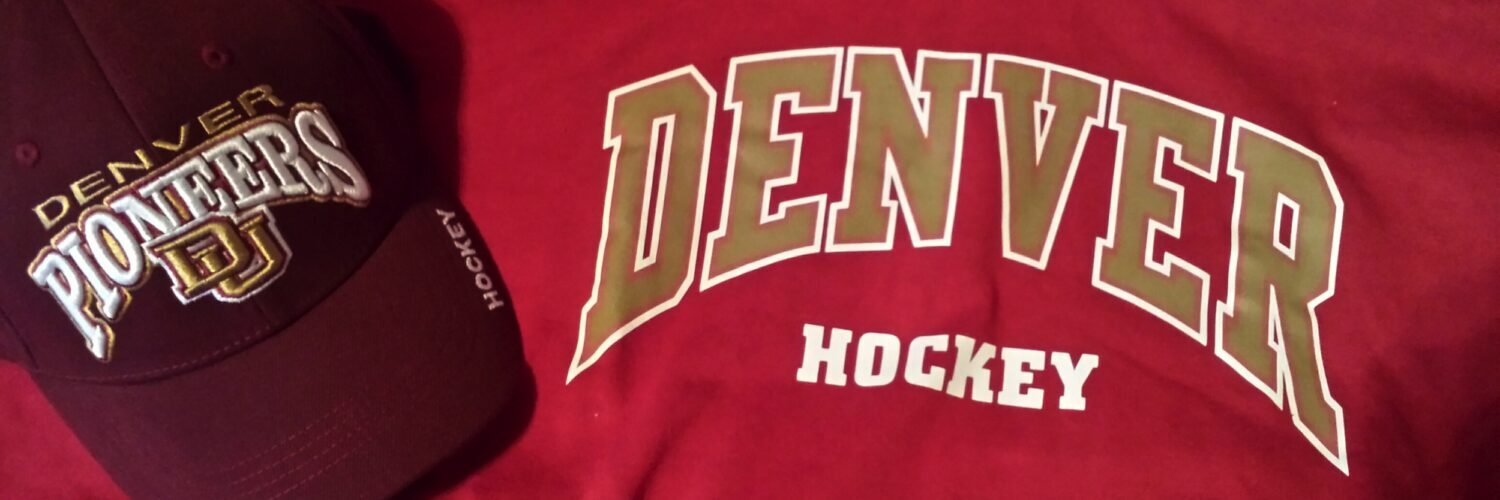
Colin Staub is part of a talented sophomore class that integrated quickly into the Denver hockey culture. The result was the Pioneers reached the Frozen Four last season and are positioned to do it again this season. Photo courtesy of Shannon Valerio, DU Athletics
Off-ice chemistry and a changing culture within the Denver hockey program have been one of its keys to breaking through in the regular and post-seasons under coach Jim Montgomery.
As important has been the up-tempo style of play the top-ranked Pioneers have embraced under their fourth-year coach. It’s in-your-face in a pressure sense, not a pick your Chiclets out of the glass sense. And there are several aspects to it.
The transition
Part of the Pioneers’ overall improvement has been their grasp of Montgomery’s system has improved. Having a large senior class with four years of familiarity with it has been an added bonus.
“A lot of it is everyone is more confident with Monty’s system than we were,” senior defenseman Matt VanVoorhis said. “My first year the only guy who knew it was Evan Janssen (who played in juniors for Montgomery in Dubuque of the United States Hockey League). Every year we’re getting better and better at it because more guys know what to do.”
Last season then captain Grant Arnold and alternate captain Nolan Zajac told me that teaching the younger players the systems was the biggest challenge for the first half of the season. So it shouldn’t be a surprise that in each of the past two campaigns the Pioneers took flight in the second half.
Experience is your friend in Montgomery’s system.
“I think it’s one more year under everyone’s belts playing under Monty, knowing his details, how everything works, how we prepare. That obviously helps,” Janssen said. “The way he wants us to play is fast, we’re coming at you, we’re not going to sit back. For a lot of guys it’s different.
“The longer you’re in it, everything becomes more comfortable. Our senior class has done a great job leading the young guys, which is part of why we’ve had the success we’ve had so far.”
Offense
Playing a puck-possession style is one thing, playing it with highly skilled players is another, and if Montgomery’s first three full classes are characterized by anything it is their skating ability and skill.
Danton Heinen was an elite college forward and a high Boston Bruins draft choice who signed last summer after his sophomore season. Classmates Tariq Hammond and Adam Plant are exceptional skating defensemen who bring an array of skills, not the least of which is the ability to jump into plays and still be able to recover if the puck changes hands.
Montgomery’s next class included NHL draft picks Troy Terry and Dylan Gambrell up front as well as defenseman Blake Hillman. In addition, wings Jarid Lukosevicius and Logan O’Connor offer scoring prowess.
This season’s freshman include a first-round NHL pick in Henrik Borgstrom, who some nights has looked like he could play in the NHL … now, the elusive Liam Finlay, fleet Tyson McLellan, and defenseman Michael Davies, who possesses elite hockey sense and skating.
Simply put, the Pioneers have a depth of talent right now that is uncommon in all but the top college hockey programs. The level and amount of it alone would create problems for opponents. But when the pedal is constantly pushed to the metal, you have a 29-win team entering the NCAA Tournament at the No. 1 overall seed.
Defensively
The pressure extends to the other end of the ice as well. The Pioneers seek to push everything to the outside, collect the puck after errant shots or Tanner Jaillet first saves and make quick, clean exits from their zone. Because all of their D skate so well, it can be a one-man undertaking or they can find lanes to push the puck to the skilled forwards.
VanVoorhis said the defensive style was an adjustment for him.
“It’s a really aggressive style with our gaps, that’s been an ongoing adjustment for me but it’s getting better,” VanVoorhis said. “He wants tighter gaps than most of us were used to playing.
“We have a lot of high-end talent, everyone was probably a go-to guy in junior so we’ve had to find a comfort level in roles we haven’t done before.”
So it should come as no surprise that Hillman and Davies took off in the second halves of their respective freshman seasons.
Behind the bench
I asked Janssen if Montgomery has evolved as a coach from his time in Dubuque.
“He’s always been unbelievable coach. He’s so detail oriented. His preparation is still the same,” the senior said. “His first first year at Denver, I wouldn’t say he was different, things felt different because no one knew his systems.
“I felt like an older guy because no one knew what to do in certain situations. Winning solves a lot. When you’re not winning, things are more stressful around the rink and such. As far as coaching style, I don’t think anything has changed.”
And that would include an open-door policy, which VanVoorhis said has been another key to the Pioneers’ growth.
“The communication between players and coaches has increased a ton in four years,” he said. “We have the ability to go to Monty, for example, and tell him if we’re tired.
“The first year was tougher with a new coach because you’re not sure where you stand, everything is more business-like. Monty is business-like but he values relationships. He’ll be honest with you but as a player that’s great because it makes it easier when you know where he’s coming from.”
Hopefully this, and the previous post on some of the program’s intangible growth patterns, gives you a better picture of “Denver hockey.”




Be the first to comment on "What does Denver hockey mean, part 2"